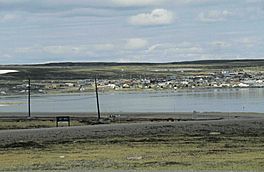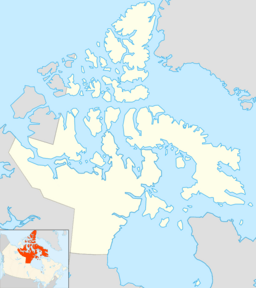Baker Lake (Nunavut) facts for kids
Quick facts for kids Baker Lake |
|
|---|---|
 |
|
| Location | Kivalliq Region, Nunavut |
| Coordinates | 64°10′N 095°30′W / 64.167°N 95.500°W |
| Primary inflows | Thelon River, Kazan River |
| Primary outflows | Chesterfield Inlet |
| Basin countries | Canada |
| Surface area | 1,887 km2 (729 sq mi) |
| Surface elevation | 2 m (6 ft 7 in) |
| Settlements | Baker Lake |
Baker Lake is a large lake located in the Kivalliq Region of Nunavut, Canada. Its name in the Inuktitut language is Qamani'tuaq, which means 'where the river widens'.
This lake is fed by two main rivers: the Thelon River from the west and the Kazan River from the south. The water then flows out into Chesterfield Inlet. Baker Lake covers an area of about 1,887 square kilometers (729 square miles). It has several named bays and a few islands.
History of Baker Lake
The area around Baker Lake has been home to the Inuit people for a very long time.
Early Explorers
The first European to reach Baker Lake was William Christopher in 1762. He arrived at the lake by traveling through Chesterfield Inlet.
First Settlements
The modern-day Inuit community of Baker Lake is located at the western end of the lake. It is near where the Thelon River flows into the lake.
The first non-Inuit presence in the area was a post set up by the North-West Mounted Police in 1915. This police post was built at the eastern end of the lake.
A year later, in 1916, the Hudson's Bay Company also set up a trading post. This first post was at the delta of the Kazan River. In 1930, the Hudson's Bay Company moved its post to where the community is today.
Wildlife Around the Lake
The region around Baker Lake is rich in wildlife. It is an important home for two large groups of caribou: the Beverly and Qamanirjuaq herds. Many other animals that live in northern Canada's Arctic also make their home here.
See also
 In Spanish: Lago Baker para niños
In Spanish: Lago Baker para niños


